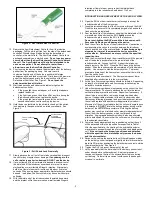
- 3 -
Figure 2
– Azur Detachment Controller
13. Remove the Azur Detachment Controller from its protective
packaging. Pull the white pull-tab from the side of the detachment
controller. Discard the pull-tab and place the detachment
controller in the sterile field. The Azur Detachment Controller is
packaged separately as a sterile device.
Do not use any power
source other than the Azur Detachment Controller to detach
the coil. The Azur Detachment Controller is intended to be
used on one patient. Do not attempt to re-sterilize or
otherwise re-use the Azur Detachment Controller.
14. Prior to using the device, remove the proximal end of the delivery
pusher from the packaging hoop. Use care to avoid
contaminating this end of the delivery pusher with foreign
substances such as blood or contrast. Firmly insert the proximal
end of the delivery pusher into the funnel section of the Azur
Detachment Controller. See Figure 2.
Do not push the
detachment button at this time.
15. Wait three seconds and observe the indicator light on the
detachment controller.
If the green light does not appear or if a red light appears,
replace the device.
If the light turns green, then turns off at any time during the
three-second observation, replace the device.
If the green light remains solid green for the entire three-
second observation, continue using the device.
16. Hold the device just distal to the shrink-lock and pull the shrink-
lock proximally to expose the tab on introducer sheath. See
Figure 3.
Figure 3 - Pull Shrink Lock Proximally
17. Slowly advance the coil out of the introducer sheath and inspect
the coil for any irregularities or damage.
If any damage to the
coil or delivery pusher is observed, DO NOT use the device.
18. If pre–softening of the Azur implant is desired, advance it out of
the distal end of the introducer sheath and immerse it in warm
sterile saline or warm lactated Ringer’s injection. Alternatively,
hold it in a flow of steam until it curls, usually about five to ten
seconds. When using steam, appropriate sterile technique should
be used. In addition, the Azur system may be used without pre-
softening.
19. With the distal end of the introducer sheath pointed downward
and the implant still in the warm saline, warm lactated Ringer’s
injection or flow of steam, gently retract the implant back
completely into the introducer sheath about 1 to 2 cm.
INTRODUCTION AND DEPLOYMENT OF THE AZUR SYSTEM
20. Open the RHV on the microcatheter just enough to accept the
introducer sheath of the Azur system.
21. Insert the introducer sheath of the Azur system through the RHV.
Flush the introducer until it is completely purged of air and saline
flush exits the proximal end.
22. Seat the distal tip of the introducer sheath at the distal end of the
microcatheter hub and close the RHV
lightly
around the
introducer sheath to secure the RHV to the introducer.
Do not over-tighten the RHV around the introducer sheath.
Excessive tightening could damage the device.
23. Push the coil into the lumen of the microcatheter. Use caution to
avoid catching the coil on the junction between the introducer
sheath and the hub of the microcatheter.
Initiate timing using a
stopwatch or timer at the moment the device enters the
microcatheter. Detachment must occur within the specified
reposition time.
24. Push the Azur system through the microcatheter until the proximal
end of the delivery pusher meets the proximal end of the
introducer sheath. Loosen the RHV. Retract the introducer
sheath just out of the RHV. Close the RHV around the delivery
pusher. Slide the introducer sheath completely off of the delivery
pusher. Use care not to kink the delivery system. To prevent
premature hydration of the Azur system, ensure that there is flow
from the saline flush.
25. Discard the introducer sheath. The Azur system cannot be re-
sheathed after introduction into the microcatheter.
26. At this time, fluoroscopic guidance should be initiated. Depending
on length of microcatheter used, fluoroscopy initiation may be
delayed to minimize exposure.
27. Under fluoroscopic guidance, slowly advance the coil out the tip of
the microcatheter. Continue to advance the coil into the lesion
until optimal deployment is achieved. Reposition if necessary. If
the coil size is not suitable, remove and replace with another
device. If undesirable movement of the coil is observed under
fluoroscopy following placement and prior to detachment, remove
the coil and replace with another more appropriately sized coil.
Movement of the coil may indicate that the coil could migrate once
it is detached.
DO NOT
rotate the delivery pusher during or after
delivery of the coil into the vasculature. Rotating the delivery
pusher may result in a stretched coil or premature detachment of
the coil from the delivery pusher, which could result in coil
migration. Angiographic assessment should also be performed
prior to detachment to ensure that the coil mass is not protruding
into undesired vasculature.
28. Complete the deployment and any repositioning so that the coil
will be detached within the reposition time specified in Table 1.
After the specified time, the swelling of the hydrophilic polymer
may prevent passage through the microcatheter and damage the
coil.
If the coil cannot be properly positioned and detached
within the specified time, simultaneously remove the device
and the microcatheter
.
29. Advance the coil into the desired site until the radiopaque marker
on the delivery pusher is aligned or slightly distal of microcatheter
distal tip RO marker, positioning the detachment zone just outside
the microcatheter tip. See Figure 4.
30. Tighten the RHV to prevent movement of the coil.
31. Verify repeatedly that the distal shaft of the delivery pusher is not
under stress before coil detachment. Axial compression or
tension could cause the tip of the microcatheter to move during
coil delivery. Catheter tip movement could cause the aneurysm
or vessel to perforate.
Pull shrink-lock
proximally
Tab on introducer
sheath























